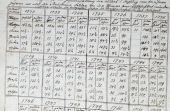1 cubic foot of water is 7.43 gallons
1 inch of rain across a sqft of land is 1/12 cubic feet=7.43/12=.62 gallons. That's about 2 1/2 quarts.
Water per plant is dependent on how many plants you can squeeze into an area.
I grow my vegetables in beds. 4' wide so I can reach the center without stomping on stuff, 50' long matches the length of drip hose.
Total area is 200 sqft/bed.
To match 1" of rain across the entire bed, I need 200 x .62 gallons = 124 gallons/week.
For more area, just do the math.
Let's add time to the equation...
For a crop that takes 90 days, I'll need to water 13 times.
That same 200 sqft bed needs 124 x 13 = 1612 gallons to produce the entire crop.
You'll need to do the math for your own design.
How much space for rainwater harvesting?
I have a 12x24 garage. That's 288 sqft of roof.
An inch of rain falling on that roof = 288/12 =24 cuft of water.
At 7.43 gallons/cuft, that's 178 gallons.
Not bad for a light shower.
As John Polk referenced, there are ways to decrease the water demand.
Hugelkulture will store massive amounts of water. Organic matter in the form of
compost, humus, and leaf mold will also hold several times their weight in water. I tested leaf mold and found it will hold 4 times it's own weight in water: 2 pounds of leaf mold will hold 8 pounds of water. That's a gallon. A Cubic yard of compost will run you $20-40 if you had to buy it, and weigh in at around 1000 pounds. Spread across 500 sqft, you end up with about 2 pounds of organic matter per square foot, and will hold 500 gallons of water. That will keep you going for a week after a light shower.
The method by which you deliver the water is important. With overhead spraying from a sprinkler, you can easily lose 30% of your water to wind and immediate evaporation. The sprinkler will deliver the water across a wide area, including the paths between your plants. There goes another third of the water. Landing on top of your plants, the water has time to evaporate before it can make its way into the soil. If you have mulch covering the ground, it will absorb a great deal of water before the soil gets any. It's possible to run the sprinkler all day without adding moisture to the soil.
Drip irrigation can be set up easily. The water is placed directly on the points you want to irrigate. It can be placed under the mulch. In my experience, each drip point will service a radius of a couple of feet. I set up a drip line with a 3/4" supply line down the center of a bed, with a foot long 1/4" line coming out every foot, 1 going left, one going right, with a drip tip at the end. See terrible artwork below.
The tilth of your soil has an impact on water demand. A hard, crusty soil will allow the water to run off before it can percolate into the soil. Soil that is loose and crumbly allows water to penetrate, and has more surface area to hold more water. Here's where drip irrigation shows another advantage. Overhead sprinkling and rain on bare soil will tend to compact the soil, where drip irrigation falls maybe half an inch, under low pressure, landing on the same spot. If you look at a working drip system, you see a wet spot the size of a dime.
MULCH
I've got nothing bad to say about mulch. Mulch covers the soil. It prevents the rainfall from hitting like a sledgehammer, pounding it into a hard surface. Rain can still penetrate, but the mulch is a shock absorber. Mulch acts as insulation, keeping the soil cooler in the hot sun, which translates to less evaporation. If you have mulch in place and want to add drip irrigation, the mulch can be moved to the side pretty easily, then replaced. With mulch ion top of the drip line, the water moving through the tubing does not get hot. Plants like a cool drink on a hot day, just like we do.























 1
1
















